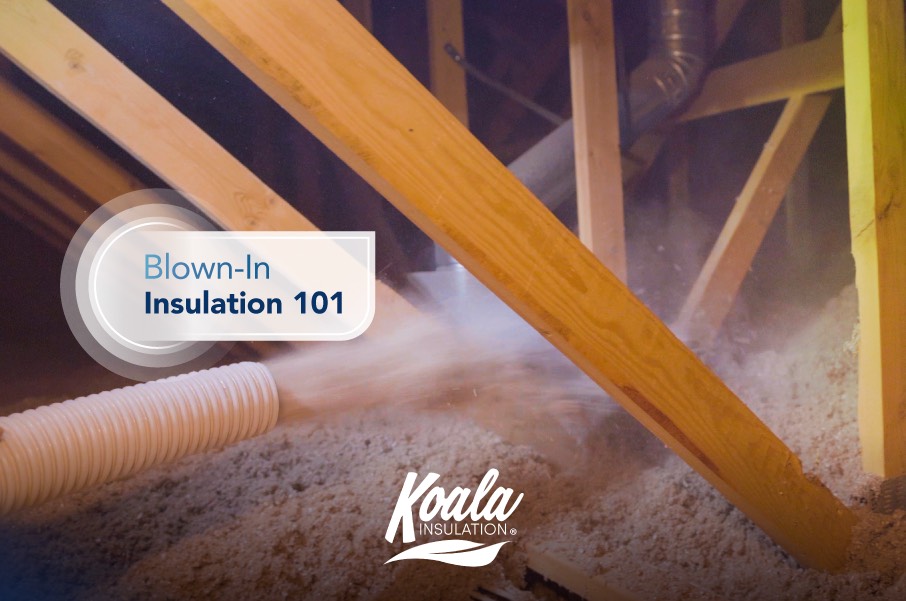Everything you need to know about Blown-in Insulation


The term blow-in insulation (or loose-fill insulation) refers to the process of filling stud or joist cavities or covering attic floors, with any loose material that has a good insulating R-value. When you install insulation in an existing closed wall or in an attic, it likely will be a loose-fill product. Studies have shown that loose-fill insulation performs up to 22% better than batts of the same R value. Making Blown-in insulation highly recommended by the US Department of Energy.
Why Blown-In?
Blown attic insulation comes in cellulose or fiberglass. Both materials have comparable R-values. Especially when it comes to fiberglass insulation, many people think of big rolls of pink or yellow sheets. However, the loose fill version of the popular insulation is more adaptive to your needs as you can control easily what depth and density you want for optimum insulation. The small particles of blown-in insulation are particularly useful for old constructions, installing blown-in insulation in this circumstance would not require you to tear down walls or having to renovate the construction like when using batts, it's also useful for spaces with low headroom clearance, irregular joist spacing or other obstructions that the material can easily adjust to and settle around to provide the best coverage. The important part about getting into all those sneaky areas on your property is that insulation creates a shield like barrier which helps the hot air from coming in, and your HVAC from working overtime by letting all the cool air escape. Blown-in insulation settles and fills all those little gaps providing maximum efficiency. The convenient mechanical delivery system through a hose allows for blown-in to be used not only for old constructions but new ones as well. Insulating your attic through this process will help lessen the amount of heat that builds up in the area. This will help increase your home’s comfort levels, keeping you from using your HVAC units excessively, leading to more savings.
Types of Blown-In Insulation
While there are a variety of materials that can be used, including styrofoam pellets or loose fiberglass fibers, the most common material used for blow-in applications is cellulose material. Cellulose insulation technically can come from any cellular plant source, such as corn cobs or sisal. But commercial cellulose insulations are generally derived from wood, and more specifically from paper: recycled newspapers, cardboard, office paper, and other common waste paper products. For this reason, cellulose insulation is considered an eco-friendly home product and a favorite among homeowners who prefer green products, with few synthetic processes or chemicals involved.
Fiberglass Blown-In
Fiberglass is currently the most common type of insulation and is as light as air. It is manufactured by heating up glass to a liquid state and spinning it into thin fibers which are used to fortify plastic filaments. These fibers will then be blown into your attic or other space and, with their R-value of around 2.7/inch, will create a barrier of protection for your home by slowing the spread of heat and sound. This makes blown-in a thermally efficient type of insulation.
Since fiberglass is made from glass, it is actually noncombustible, meaning that it does not burn. It also does not absorb water, making it mold-resistant so you can feel safe in your own home.
Cellulose Blown-In
Cellulose Blown-In Insulation is made from ground paper and one of the most environmentally friendly options as 85% of its content is recycled. The paper settles perfectly into any little crevices and therefore provides good air sealing and thermal efficiency. Due to the material, old cellulose had a high burn factor (so it's important to check your insulation and upgrade it if necessary!) but nowadays, cellulose is treated with borates which make it fire resistant and help against insects and pests while being completely harmless for humans.
What are the benefits of Blown-In Insulation?
It helps you save energy!
Insulation in general will help you keep your home at a more even, and comfortable, temperature and give your A/C unit a break from constantly working overtime. The result is a lower energy bill that will save you money.
It's an affordable option!
Blown-in Insulation is one of the most cost effective options when it comes to insulation and helps you reach the R-Value you need to stay cool without breaking the bank. Getting more bang for your buck because of all the money your saving.
It's soundproofing your home!
Due to its airtight seal, this type of insulation prevents noise from traveling through walls. Whether your neighbors are the problem, or you’re tired of hearing the pounding rain and crashing thunder as if it's inside your house, this insulation will act as a sound buffer, giving you the quiet that you need.
It's protecting the planet!
Insulation will protect the planet by saving you energy and reducing your carbon footprint but, Blown-In in particular is also one of the most environmentally friendly types of insulation made up of recycled materials.
Finding out which product is the right choice for your home doesn't have to be a hassle. Our team of experts at Koala Insulation of North Broward and Boca would be more than glad to evaluate the current situation of your home and show you the differences between the two products. Take advantage of our complimentary insulation evaluation. We'll help you make the right decision!
Find Your Location


Get a quote


